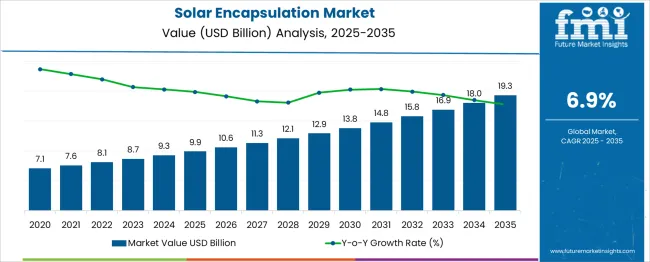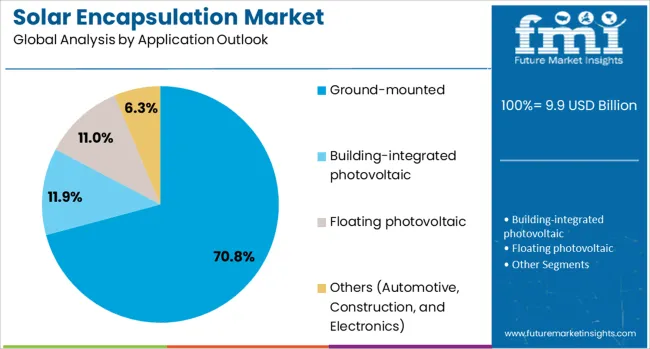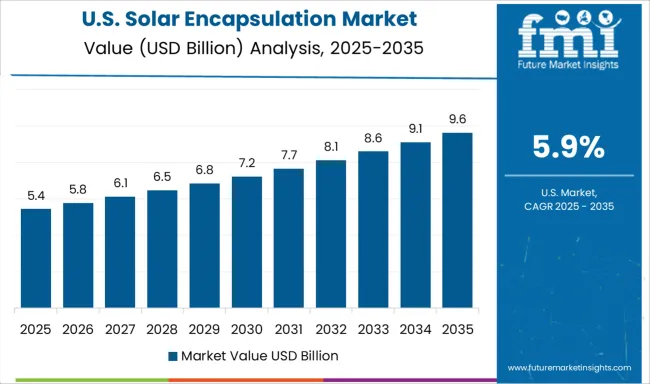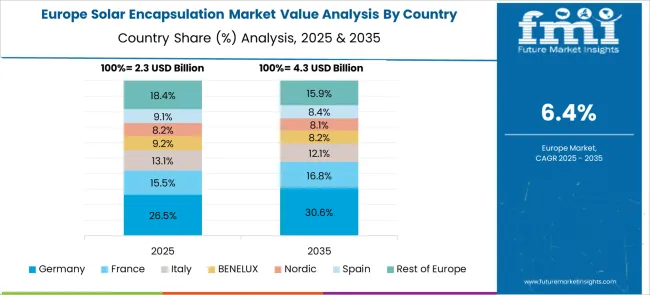The global solar encapsulation market is likely to grow from USD 9.9 billion in 2025 to approximately USD 19.3 billion by 2035, recording an absolute increase of USD 9.4 billion over the forecast period. This translates into a total growth of 94.9%, with the market forecast to expand at a compound annual growth rate (CAGR) of 6.9% between 2025 and 2035. The overall market size is expected to grow by nearly 1.95X during the same period, supported by increasing global solar energy adoption, expanding photovoltaic installations, and growing demand for efficient solar panel protection solutions.

Between 2025 and 2030, the Solar Encapsulation market is projected to expand from USD 9.9 billion to USD 13.7 billion, resulting in a value increase of USD 3.8 billion, which represents 40.4% of the total forecast growth for the decade. This phase of growth will be shaped by accelerating solar energy adoption, expanding utility-scale photovoltaic projects, and increasing demand for high-performance encapsulation materials that enhance solar panel durability and efficiency across global markets.
From 2030 to 2035, the market is forecast to grow from USD 13.7 billion to USD 19.3 billion, adding another USD 5.6 billion, which constitutes 59.6% of the overall ten-year expansion. This period is expected to be characterized by advancements in encapsulation material technologies, the expansion of floating photovoltaic installations, and the development of building-integrated photovoltaic systems. The growing focus on renewable energy infrastructure and climate change mitigation will drive demand for innovative encapsulation solutions across residential, commercial, and industrial solar applications.
| Metric | Value |
|---|---|
| Estimated Value in (2025E) | USD 9.9 Billion |
| Forecast Value in (2035F) | USD 19.3 Billion |
| Forecast CAGR (2025 to 2035) | 6.9% |
Market expansion is being supported by increasing global commitment to renewable energy transition and carbon emission reduction goals, driving widespread adoption of solar photovoltaic systems that require reliable encapsulation materials for long-term performance protection. Government incentives, subsidies, and regulatory frameworks promoting solar energy deployment are creating demand for high-quality encapsulation solutions that ensure optimal solar panel efficiency and operational longevity.
The growing focus on energy security and independence is driving investment in solar infrastructure across residential, commercial, and utility-scale applications that rely on advanced encapsulation materials for weather protection, UV resistance, and electrical insulation. Technological advancement in solar panel efficiency and manufacturing processes is creating demand for specialized encapsulation materials that support next-generation photovoltaic technologies including thin-film solar cells and flexible solar applications.
The market is segmented by material, technology, application, and region. By material, the market is divided into Ethylene Vinyl Acetate (EVA), Thermoplastic Polyurethane (TPU), Polyvinyl Butyral (PVB), Polydimethylsiloxane (PDMS), Ionomer, and Polyolefin. Based on technology, the market is categorized into crystalline silicon solar, thin-film solar, and others. In terms of application, the market is segmented into ground-mounted, building-integrated photovoltaic, floating photovoltaic, and others including automotive, construction, and electronics. Regionally, the market is divided into North America, Europe, Asia Pacific, Latin America, and Middle East & Africa.
Ethylene Vinyl Acetate (EVA) is projected to account for 65.5% of the Solar Encapsulation market in 2025. This leading share is supported by EVA's excellent optical clarity, superior adhesion properties, and proven long-term durability in solar panel applications. EVA provides optimal light transmission, weather resistance, and cost-effectiveness that make it the preferred encapsulation material for crystalline silicon solar panels. The segment benefits from established manufacturing infrastructure and extensive application experience across diverse solar installations.

Crystalline silicon solar technology is expected to represent 84.4% of encapsulation material demand in 2025. This dominant share reflects the widespread adoption of crystalline silicon photovoltaic panels in residential, commercial, and utility-scale solar installations worldwide. Crystalline silicon technology offers proven efficiency, reliability, and cost-effectiveness that drive consistent demand for compatible encapsulation materials. The segment benefits from mature manufacturing processes and comprehensive supply chain infrastructure supporting global solar deployment.

Ground-mounted applications are projected to contribute 70.8% of the market in 2025, representing utility-scale solar installations and large commercial photovoltaic projects that require substantial quantities of encapsulation materials. Ground-mounted systems offer optimal solar panel orientation, efficient installation processes, and scalable deployment capabilities that support major renewable energy projects. The segment is supported by government renewable energy targets and corporate initiatives driving large-scale solar development.
The market faces challenges, including raw material price volatility, stringent quality requirements for long-term durability, and competition from alternative photovoltaic technologies that may require different encapsulation approaches. Innovation in material science and green manufacturing continues to influence encapsulation technology development.
The growing demand for higher solar panel efficiency and extended operational life is driving development of advanced encapsulation materials that offer superior UV resistance, thermal stability, and moisture barrier properties. Next-generation encapsulation solutions incorporate improved polymer formulations and additive technologies that enhance long-term performance while maintaining optical clarity and mechanical integrity. These advanced materials support premium solar panel applications and demanding environmental conditions.
Modern solar installations are incorporating specialized applications, including floating photovoltaic systems, building-integrated photovoltaics, and flexible solar panels that require customized encapsulation solutions with specific performance characteristics. Advanced encapsulation materials enable innovative solar deployment configurations that maximize energy generation while addressing space constraints and aesthetic requirements. These specialized applications drive demand for engineered encapsulation solutions that support diverse installation environments.

| Country | CAGR (2025-2035) |
|---|---|
| China | 9.3% |
| India | 8.6% |
| Germany | 7.9% |
| France | 7.2% |
| United Kingdom | 6.6% |
| United States | 5.9% |
| Brazil | 5.2% |
Revenue from solar encapsulation materials in China is projected to exhibit the highest growth rate with a CAGR of 9.3% through 2035, driven by the country's dominant position in global solar panel manufacturing and expanding domestic solar installations. China's comprehensive photovoltaic supply chain and advanced manufacturing capabilities are creating substantial demand for high-quality encapsulation materials across diverse solar applications. Major encapsulation material producers are establishing comprehensive production facilities to serve domestic and international markets.
Revenue from solar encapsulation materials in India is expanding at a CAGR of 8.6%, supported by ambitious renewable energy targets, growing solar manufacturing capabilities, and increasing domestic solar installations across residential and commercial sectors. The country's expanding solar industry and government incentives are driving demand for reliable encapsulation solutions that ensure optimal solar panel performance in challenging environmental conditions. Domestic and international companies are investing in encapsulation material production to serve growing market demand.
Demand for solar encapsulation materials in Germany is projected to grow at a CAGR of 7.9%, supported by the country's leadership in renewable energy technology and focuses on high-quality solar installations that require advanced encapsulation solutions. German solar companies are implementing premium encapsulation materials that maximize energy yield and ensure long-term system reliability. The market is characterized by focus on technological innovation and green manufacturing practices.
Demand for solar encapsulation materials in France is expanding at a CAGR of 7.2%, driven by government renewable energy commitments, expanding solar installations, and growing focuses on building-integrated photovoltaic systems that require specialized encapsulation solutions. French companies are implementing comprehensive solar deployment programs that utilize advanced encapsulation materials for diverse application requirements. The market benefits from supportive regulatory frameworks and established solar industry infrastructure.
Demand for solar encapsulation materials in the UK is growing at a CAGR of 6.6%, supported by renewable energy targets, expanding residential solar adoption, and growing commercial solar installations that require reliable encapsulation solutions. British companies are prioritizing solar development with focuses on long-term performance and environmental responsibility. The market is characterized by focus on quality standards and comprehensive system optimization.

Demand for solar encapsulation materials in the USA is expanding at a CAGR of 5.9%, driven by federal renewable energy incentives, state-level solar mandates, and expanding utility-scale solar projects that require substantial quantities of encapsulation materials. Large solar developers are implementing comprehensive photovoltaic installations that utilize proven encapsulation technologies for optimal performance and longevity. The market benefits from established supply chains and comprehensive manufacturing capabilities.
Revenue from solar encapsulation materials in Brazil is growing at a CAGR of 5.2%, driven by expanding distributed solar generation, growing utility-scale installations, and increasing awareness of renewable energy benefits that drive demand for reliable encapsulation solutions. The country's abundant solar resources and supportive regulatory frameworks are creating opportunities for solar deployment across residential, commercial, and industrial applications. Solar industry development is supporting demand for quality encapsulation materials.

The solar encapsulation market is growing rapidly across global markets, with China leading at a 9.3% CAGR through 2035, driven by dominant solar panel manufacturing capabilities and expanding domestic installations. India follows at 8.6%, supported by ambitious renewable energy targets and growing solar manufacturing infrastructure, while Germany records 7.9% focusing on premium quality and technology innovation. France grows at 7.2% with renewable energy commitments and building-integrated photovoltaic expansion, the United Kingdom shows 6.6% growth focusing on green development, the United States expands at 5.9% with large-scale deployment and market innovation, and Brazil maintains 5.2% growth supported by distributed solar generation and utility-scale development.
The European solar encapsulation market is characterized by advanced technology adoption and stringent quality standards that promote high-performance encapsulation solutions. Countries across the region are implementing comprehensive renewable energy programs that drive consistent demand for reliable encapsulation materials supporting diverse solar applications. The market benefits from established manufacturing infrastructure, supportive regulatory frameworks, and strong focuses on sustainable energy transition that creates long-term growth opportunities for encapsulation material suppliers.

The solar encapsulation market is defined by competition among specialty chemical companies, solar industry suppliers, and advanced material manufacturers offering diverse encapsulation solutions for photovoltaic applications. Companies are investing in advanced material technologies, manufacturing scale optimization, quality assurance systems, and application development to deliver high-performance encapsulation materials that ensure optimal solar panel protection and longevity. Strategic partnerships, technology licensing, and geographic expansion are central to strengthening product portfolios and market presence.
Major encapsulation material suppliers maintain comprehensive production capabilities and extensive distribution networks that serve global solar manufacturing and installation markets with consistent product quality and reliable supply. HANGZHOU FIRST APPLIED MATERIAL CO., LTD., China-based, offers comprehensive EVA encapsulation solutions focusing on manufacturing excellence and cost competitiveness. First Solar provides integrated photovoltaic solutions with specialized encapsulation technologies for thin-film applications. DuPont delivers advanced polymer encapsulation materials with focus on durability and performance optimization. 3M and Dow offer specialty encapsulation solutions with focuses on material science innovation and application versatility. Mitsui Chemicals Inc., LG Chem, Shin-Etsu Chemical Co., Ltd., and RenewSys India Pvt. Ltd. provide comprehensive encapsulation expertise, advanced manufacturing capabilities, and application support across global and regional solar markets.
| Item | Value |
|---|---|
| Quantitative Units | USD 19.3 billion |
| Material | Ethylene Vinyl Acetate (EVA), Thermoplastic Polyurethane (TPU), Polyvinyl Butyral (PVB), Polydimethylsiloxane (PDMS), Ionomer, Polyolefin |
| Technology | Crystalline Silicon Solar, Thin-Film Solar |
| Application | Ground-mounted, Building-integrated photovoltaic, Floating photovoltaic, Others (Automotive, Construction, and Electronics) |
| Regions Covered | North America, Europe, Asia Pacific, Latin America, Middle East & Africa |
| Country Covered | United States, Canada, United Kingdom, Germany, France, China, Japan, South Korea, India, Brazil, Australia and 40+ countries |
| Key Companies Profiled | HANGZHOU FIRST APPLIED MATERIAL CO., LTD.; First Solar; DuPont; 3M; Dow; Mitsui Chemicals, Inc.; LG Chem; Shin-Etsu Chemical Co., Ltd.; RenewSys India Pvt. Ltd. |
| Additional Attributes | Dollar sales by material, technology, and application, regional demand trends across North America, Europe, and Asia-Pacific, competitive landscape with established chemical companies and solar industry suppliers, adoption of advanced encapsulation material technologies, integration with next-generation photovoltaic systems and manufacturing processes, innovations in green encapsulation solutions and environmental compatibility, and development of specialized materials for emerging solar applications including floating and building-integrated installations. |
North America
The global solar encapsulation market is estimated to be valued at USD 9.9 billion in 2025.
The market size for the solar encapsulation market is projected to reach USD 19.3 billion by 2035.
The solar encapsulation market is expected to grow at a 6.9% CAGR between 2025 and 2035.
The key product types in solar encapsulation market are ethylene vinyl acetate (eva), thermoplastic polyurethane (tpu), polyvinyl butyral (pvb), polydimethylsiloxane (pdms), ionomer and polyolefin.
In terms of technology outlook, crystalline silicon solar segment to command 84.4% share in the solar encapsulation market in 2025.






Our Research Products

The "Full Research Suite" delivers actionable market intel, deep dives on markets or technologies, so clients act faster, cut risk, and unlock growth.

The Leaderboard benchmarks and ranks top vendors, classifying them as Established Leaders, Leading Challengers, or Disruptors & Challengers.

Locates where complements amplify value and substitutes erode it, forecasting net impact by horizon

We deliver granular, decision-grade intel: market sizing, 5-year forecasts, pricing, adoption, usage, revenue, and operational KPIs—plus competitor tracking, regulation, and value chains—across 60 countries broadly.

Spot the shifts before they hit your P&L. We track inflection points, adoption curves, pricing moves, and ecosystem plays to show where demand is heading, why it is changing, and what to do next across high-growth markets and disruptive tech

Real-time reads of user behavior. We track shifting priorities, perceptions of today’s and next-gen services, and provider experience, then pace how fast tech moves from trial to adoption, blending buyer, consumer, and channel inputs with social signals (#WhySwitch, #UX).

Partner with our analyst team to build a custom report designed around your business priorities. From analysing market trends to assessing competitors or crafting bespoke datasets, we tailor insights to your needs.
Supplier Intelligence
Discovery & Profiling
Capacity & Footprint
Performance & Risk
Compliance & Governance
Commercial Readiness
Who Supplies Whom
Scorecards & Shortlists
Playbooks & Docs
Category Intelligence
Definition & Scope
Demand & Use Cases
Cost Drivers
Market Structure
Supply Chain Map
Trade & Policy
Operating Norms
Deliverables
Buyer Intelligence
Account Basics
Spend & Scope
Procurement Model
Vendor Requirements
Terms & Policies
Entry Strategy
Pain Points & Triggers
Outputs
Pricing Analysis
Benchmarks
Trends
Should-Cost
Indexation
Landed Cost
Commercial Terms
Deliverables
Brand Analysis
Positioning & Value Prop
Share & Presence
Customer Evidence
Go-to-Market
Digital & Reputation
Compliance & Trust
KPIs & Gaps
Outputs
Full Research Suite comprises of:
Market outlook & trends analysis
Interviews & case studies
Strategic recommendations
Vendor profiles & capabilities analysis
5-year forecasts
8 regions and 60+ country-level data splits
Market segment data splits
12 months of continuous data updates
DELIVERED AS:
PDF EXCEL ONLINE
Solar Encapsulation Materials Market
Solar Module Recycling Service Market Size and Share Forecast Outlook 2025 to 2035
Solar Tracking Module Market Size and Share Forecast Outlook 2025 to 2035
Solar Analyzer Market Size and Share Forecast Outlook 2025 to 2035
Solar Aluminum Alloy Frame Market Size and Share Forecast Outlook 2025 to 2035
Solar Grade Monocrystalline Silicon Rods Market Analysis - Size, Share, and Forecast Outlook 2025 to 2035
Solar Vehicle Market Size and Share Forecast Outlook 2025 to 2035
Solar PV Module Market Size and Share Forecast Outlook 2025 to 2035
Solar Pumps Market Analysis - Size, Share, and Forecast Outlook 2025 to 2035
Solar Mobile Light Tower Market Size and Share Forecast Outlook 2025 to 2035
Solar PV Recycling Market Size and Share Forecast Outlook 2025 to 2035
Solar Tracker for Power Generation Market Size and Share Forecast Outlook 2025 to 2035
Solar Panel Market Size and Share Forecast Outlook 2025 to 2035
Solar-Powered Active Packaging Market Analysis - Size, Share, and Forecast Outlook 2025 to 2035
Solar Panel Recycling Management Market Size and Share Forecast Outlook 2025 to 2035
Solar Photovoltaic (PV) Market Size and Share Forecast Outlook 2025 to 2035
Solar EPC Market Size and Share Forecast Outlook 2025 to 2035
Solar-Powered UAV Market Size and Share Forecast Outlook 2025 to 2035
Solar Panel Cleaning Market Size and Share Forecast Outlook 2025 to 2035
Solar Salt Market Size and Share Forecast Outlook 2025 to 2035

Thank you!
You will receive an email from our Business Development Manager. Please be sure to check your SPAM/JUNK folder too.
Chat With
MaRIA